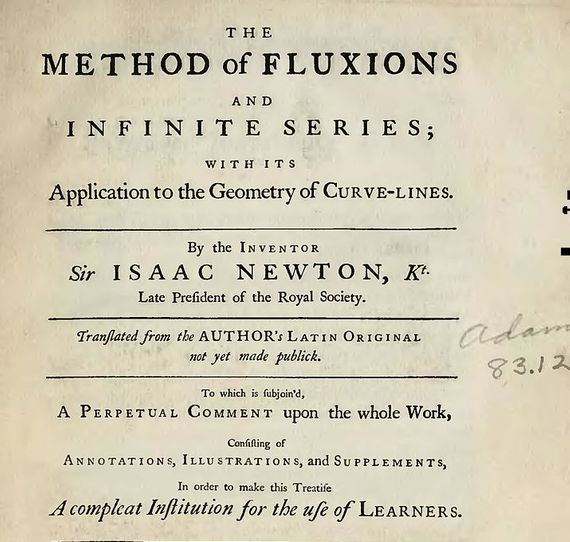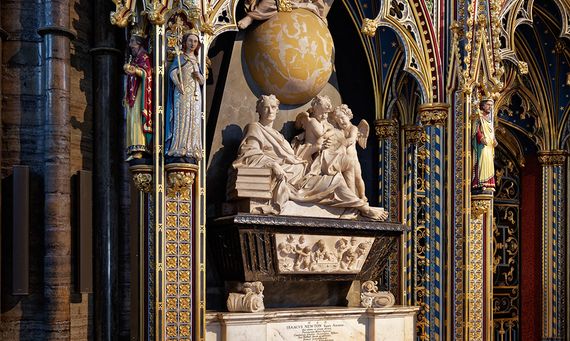The young Newton returned at the age of 23 to his small hometown of Woolsthorpe, in Lincolnshire (England), fleeing the bubonic plague that caused the closure of the University of Cambridge and wiped out a fifth of the population of London. And it was on his family’s sheep farm, with hardly any contact with the outside world, that he performed one of the most amazing intellectual exploits in history.
In just two years, from 1665 to 1666, Newton simultaneously developed differential and integral calculus, in addition to his theories about the nature of light and the force of gravity. The new mathematical and physics tools devised by the young Englishman in that short period revolutionized the science of his time and form the basis of our current technological world.

Infinitesimal calculus, although it is strictly included in the mathematical field, has turned out to be a powerful language that allows one to describe the laws of nature with amazing precision. Using the ideas of Isaac Newton (25 December 1642 – 20 March 1726, according to the calendar then in use in England) modern researchers can study the movement of clouds, the seas, the orbits of satellites, viral infections, the design of vehicles, economic growth…
Newton conceived of two revolutionary mathematical concepts: that of the derivative and the integral. The derivative is related to the progression over time of values such as speed and acceleration. It is an instantaneous rate of change, which indicates in what way (how fast) the values are being modified. In geometry, the derivative allows one to calculate the slopes of curves and, consequently, the tangent line to a given curve.
On the other hand, the integral is used to calculate areas and volumes, as well as to find the centre of gravity of bodies. The surprising thing is that both notions are related by one of the most beautiful expressions of mathematics, the fundamental theorem of infinitesimal calculus, which affirms that derivation and integration are inverse operations; in other words, when applied successively, you return to the initial value.

In 1669, Newton gave his mentor, Isaac Barrow, a manuscript, De analysi per aequationes numero infinorum terminorum, in which the bases of the new differential calculus appear for the first time. In the work, Newton presents an approximate method to solve equations, today called the Newton-Raphson method, and enunciates and demonstrates a formula to calculate the area enclosed by a generalized parabola. This expression had already been found earlier by another English mathematician, John Wallis (1616-1703), but the novelty introduced by Newton lay in the techniques used, which he called the “method of fluxions” and the “inverse method of fluxions.”
Mathematics to study movement
His work was, in practice, the first application of the fundamental theorem of infinitesimal calculus to a concrete example, which showed that the methods of tangents (derivatives) and quadratures (areas, i.e. integrals) were inversely related to each other.
Newton’s most important work on this subject was De methodis serierum et fluxionum, published posthumously in 1736. There he introduced the concept of fluents, as a quantity that varies with time, and that of fluxions, as its velocity or derivative with respect to time. Newton, in addition, developed the algorithms for the calculation of fluxions, which we know today as the rules for deriving sums, products, quotients…, and that we study in first-year baccalaureate courses.

He also showed how to calculate the area of a curve, which is currently called calculating the primitive of a function (which in his terminology was “obtaining the fluent of a fluxion”). Newton went on to apply his newly created calculus to problems of maximums and minimums, and in this way he managed to solve, one by one, the problems that had troubled his predecessors: scientists like the Italians Bonaventura Cavalieri and Evangelista Torricelli and the Frenchmen Gilles de Roberval, René Descartes and Pierre de Fermat, among many others, had done work in that area, dedicated to solving specific physics problems, but without having managed to find a general solution like Newton did.
His two new tools (derivatives and integrals) added to the elementary operations of mathematics and were ideal for analysing movement — and, therefore, almost all physical phenomena. Based on these ideas, Newton developed a whole new mathematics—mathematical analysis—that today remains one of the most active branches of research.
A bitter scientific controversy
However, young Newton did not put much effort into disseminating his results. Although he delivered his first treatise to Isaac Barrow in 1669 and sent some copies to different mathematical circles in England, it was not formally published until 1711. Meanwhile, another mathematician, Gottfried Leibniz, had developed an equivalent theory. When Newton received news of these works, he lost little time in claiming his authorship of infinitesimal calculus, which gave rise to a bitter controversy that would even involve scientific societies.

The truth is that it is possible that both men came to similar ideas in the same period. At the beginning of the 17th century, mathematical methods had already been developed that involved infinite processes to calculate areas delimited by curves or volumes, or to find maximums and minimums of certain problems. Newton himself admitted, in a letter to his colleague (and rival) Robert Hooke: “If I have seen further it is by standing on the shoulders of Giants.”
Modesty aside, the genius of Newton left an indelible mark on the development of modern civilization, and his intellectual figure has not had an equal, as it reads on his epitaph: “Mortals rejoice that there has existed such and so great an ornament of the human race!”
Comments on this publication